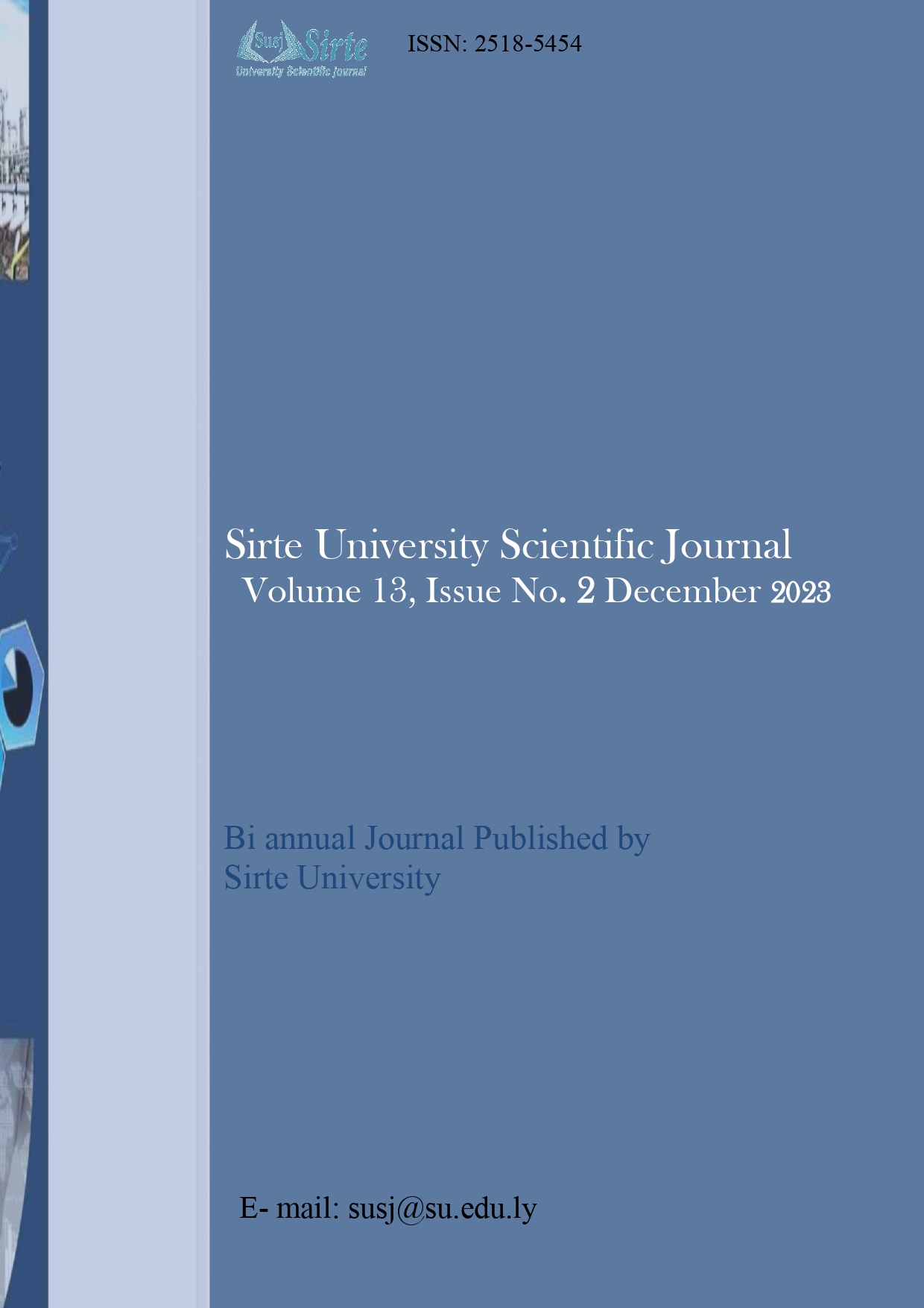Oxidative Stress in Brain Induced by Artificial Sweetener (Saccharin) and the Possible Influence of the Coenzyme Q 10 in Male Rats.
DOI:
https://doi.org/10.37375/susj.v13i2.2524الكلمات المفتاحية:
Saccharin;Coenzyme Q10، Stress، Antioxidant and Ratsالملخص
: Food additives draw in customers, enhance food quality, help people lose weight, and substitute sugar in food—all while having a potentially harmful impact on the health of both adults and children.
Aim: To look into the negative effects of saccharin (Sac) on oxidative stress in brain tissue and determine the protective effects of CoQ10 on brain tissue.
Methods: Six groups of ten rats each were created out of the sixty rats. 1st control group, 2nd treated with 20 mg/kg of CoQ10 b.wt. 3rd treated with Sac 1/10 LD50, 4th treated with Sac 1/20 LD50, 5th treated with Sac 1/10 LD50 plus CoQ10 and 6th treated with Sac 1/20 LD50 plus CoQ10. Sac and CoQ10 were taken orally for a duration of thirty days. Then brain oxidative stress tests were performed.
Results: Saccharin at both low and high dosages showed a notable rise in brain oxidative markers (GSSG, NO and 8OHDG) in contrast to the group under authority. However, in contrast, CoQ10 supplementation reduced brain oxidative markers (GSSG, NO and 8OHDG) compared to Sac groups and nearly recovery in comparison with a control cohort.
Conclusions:It is possible to draw the conclusion that saccharin has negative effects on brain tissue and raises oxidative indicators both at low and high dosages. However, applications of CoQ10 showed reduction in brain oxidative stress markers and protection from oxidative damage.
المراجع
Al-Kareem ZA, Aziz ND, Zghair MA, (2022) Hepatoprotective Effect of Coenzyme Q10 in Rats with Diclofenac Toxicity. Arch Razi Inst. 2022 Apr; 77(2): 599–605.
Alsoufi MA, Aziz RA, Hussein ZG, (2017) Effect of some artificial sweeteners consumption in biochemical parameters of rats. Curr. Res. Microbiol. Biotechnol., 5 (3): 1095-1099.
Amin KA, AlMuzafar HM, (2015) Alterations in lipid profile, oxidative stress and hepatic function in rat fed with saccharin and methyl-salicylates. Int J Clin Exp Med., 8: 6133-6144.
Amin KA, Al-muzafar HM, Abd-Elsttar AH (2016) Effect of sweetener and flavoring agent on oxidative indices, liver and kidney function levels in rats. Indian J Exp Biol., 2016; 54(1): 56-63.
Anushkkaran P, (2019) Artificial sweeteners. International Journal of Research and Review., 9;55(10): 681-186.
Azeez OH, Alkass SY, Persike DS (2019) Long-Term Saccharin Consumption and Increased Risk of Obesity, Diabetes, Hepatic Dysfunction, and Renal Impairment in Rats., Medicina (Kaunas). 2019 Oct; 55(10): 681
Bouyahya A, El Menyiy N, Oumeslakht L, El Allam A, Balahbib A, Rauf A, Muhammad N, Kuznetsova E, Derkho M, Thiruvengadam M, Mohammad Shariati A, El Omar N, (2021) Preclinical and Clinical Antioxidant Effects of Natural Compounds against Oxidative Stress-Induced Epigenetic Instability in Tumor Cells. Antioxidants (Basel). 2021 Oct; 10(10): 1553.
Çolak DA, Uysal H, (2017) Protective effects of coenzyme Q10 and resveratrol on oxidative stress induced by various dioxins on transheterozigot larvae of Drosophila melanogaster. Toxicol Res. 2017;6(4):521–5.
Díaz-Casado E, Quiles Morales J, (2019) The Paradox of Coenzyme Q10 in Aging. oai:digibug.ugr.es:10481/57476.
Djukanovic S, Cvetkovic S, Mitic-Culafic D, Knezevic-Vukcevic J, Nikolic B, (2019) Anti-genotoxic potential of Gentiana lutea extracts against the food sweetener saccharin.Earth and Environmental Science 333 (2019) 012059
Gong T, Wei Q, Mao D, (2016) Effects of daily exposure to saccharin and sucrose on testicular biologic functions in mice. Biology of Reproduction, 95(6):116 (1–13).
Graille M, Wild P, Jean-Jacques S, Hemmendinger SM, (2020) Urinary 8-OHdG as a Biomarker for Oxidative Stress: A Systematic Literature Review and Meta-Analysis.Int. J. Mol. Sci. 2020, 21(11), 3743.
Hasan HM Alkass SY (2020) Impact of Long Term Cyclamate and Saccharin Consumption on Biochemical Parameters in Healthy Individuals and Type 2 Diabetes Mellitus Patients. Research Square.9: 44- 50.
Hasan HM, Alkass SY, Persike de Oliveira DS (2023) Impact of Long-Term Cyclamate and Saccharin Consumption on Biochemical Parameters in Healthy Individuals and Type 2 Diabetes Mellitus Patients. Medicina.; 59(4), 698.
Hassan SS, Samanta SR, Dash, S (2022) The neuroprotective effects of fisetin, a natural flavonoid in neurodegenerative diseases: Focus on the role of oxidative stress. Front. Pharmacol, Volume 13 - 2022.
Helal EGE, Al-Shamrani A, Abdelaziz MA, El-Gamal MS, (2019) Comparison between The Effect of Sucralose and Sodium Saccharin on Some Physiological Parameters in Male Albino Rats. The Egyptian Journal of Hospital Medicine, 74 (7): 1552- 1559.
Katerji M, Filippova M, Duerksen-Hughes P, (2019) Approaches and Methods to Measure Oxidative Stress in Clinical Samples: Research Applications in the Cancer Field. Oxid Med Cell Longev. 2019; 2019: 1279250.
Manzar H, Abdulhussein D, Timothy EY, Cordeiro MF, (2020) Cellular Consequences of Coenzyme Q10 Deficiency in Neurodegeneration of the Retina and Brain. Int J Mol Sci., 21(23): 9299.
Martemucci G, Costagliola C, Mariano M, D’andrea L, Gabriella A, (2022) Free Radical Properties, Source and Targets, Antioxidant Consumption and Health.Oxygen 2022, 2 (2), 48-78.
Moktar KA, Ayesh MHB, El-Gammal HL, Ahmed-Farid OA, Abou-khzam BAf, (2021) Effect of β-oxidation stimulant against metabolic syndrome of saccharin in rat: A behavioral, biochemical, and histological study. Journal of Applied Pharmaceutical Science., Vol. 11(01), pp 061-071.
Olama NK, Taha M, Rady HY. The potential protective role of coenzyme q10 on the cyclophosphamide induced lung toxicity in adult male albino rats: a histological and ultrastructural study. Int J Sci Rep, 2018; 4(9):225–34.
Pizzino G, Irrera N, Cucinotta M, Pallio G, Mannino F, Arcoraci V, Squadrito F, Altavilla D, Bitto A, (2017) Oxidative Stress: Harms and Benefits for Human Health. Oxid Med Cell Longev. 2017; 2017: 8416763.
Radi R, (2014) Peroxynitrite, a Stealthy Biological Oxidant. J Biol Chem.





